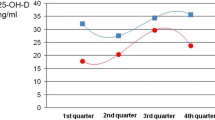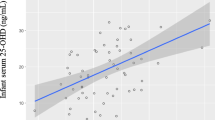Abstract
Objective
To evaluate the seasonal change in serum 25-hydroxyvitamin D (25-OHD) level in healthy infants and to relate it to common childhood morbidities.
Methods
72 healthy breastfed infants residing in Delhi were enrolled at the end of summer and followed till the end of winter [mean (SD) duration 200 (10) d]. Serum 25-OHD was estimated at baseline and follow-up. Infants were monitored for common childhood diseases.
Results
Mean (SD) serum 25-OHD level was lower at the end of winter (20.7 (8.02) ng/mL) than summer (22.9 (8.70) ng/mL) [mean difference (95% CI) −2.14 ng/mL (−3.36, −1.06), P<0.001). The seasonal distribution of children according to vitamin D status in summer and winter — Deficient (15.3%, 12.5%), Insufficient (19.4%, 30.6%) and Sufficient (65.3%, 56.9%), respectively was comparable P=0.17). The morbidity profile remained unaffected by change in vitamin D status from summer to winter.
Conclusions
Seasonal changes in vitamin D levels do not have significant clinical effect or effect on overall vitamin D status in apparently healthy infants from North India. This may have implications for results of population surveys for vitamin D status, irrespective of the season when they are conducted.
Similar content being viewed by others
References
Holick MF. Environmental factors that influence the cutaneous production of vitamin D. Am J Clin Nutr. 1995;61:638S–45S.
Rajakumar K, Hollick MF, Jeong K, Mooreet CJ. Impact of season and diet on vitamin D status of African, American and Caucasian children. Clin Pediatr. 2011;50:492–502.
Wacker M, Holick MF. Sunlight and vitamin D: A global perspective for health. Dermatoendocrinol. 2013;5:51–108.
Michaëlsson K, Wolk A, Byberg L, Mitchell A, Mallmin H, Melhus H. The seasonal importance of serum 25-hydroxyvitamin D for bone mineral density in older women. J Intern Med. 2017;281:167–78.
Huotari A, Herzig KH. Vitamin D and living in northern latitudes-an endemic risk area for vitamin D deficiency. Int J Circumpolar Health. 2008;67:164–78.
Jain V, Gupta N, Kalaivani M, Jain A, Sinha A, Agarwal R. Vitamin D deficiency in healthy breastfed term infants at 3 months and their mothers in India: Seasonal variation and determinants. Indian J Med Res. 2011;133:267–73.
WHO Multicentric Growth Reference Study Group. WHO child growth standards based on length/ height, weight and age. Acta Pediatr. 2006;Supp 450:76-85.
American College of Emergency Physicians. Clinical Policy for Children Younger Than Three Years Presenting to the Emergency Department with Fever: ACEP Guidelines. Ann Emerg Med. 2003;42:530–45.
World Health Organization. The Treatment of Diarrhoea: A Manual for Physicians and Other Senior Health Workers. Geneva: World Health Organization; 2005. Available at URL: http://www.who.int/child_adolescent_health/documents/9241593180/en/index.html. Accessed March 14, 2016.
World Health Organization. Acute Respiratory Infections in Children: Case Management in Small Hospitals in Developing Countries, a Manual for Doctors and Other Senior Health Workers. Available at URL: http://www.who.int/iris/handle/10665/61873. Accessed March 14, 2016.
van de Beek, Cabellos C, Dzupova O, Esposito S, Klein M, Kloek AT, et al. ESCMID guideline: Diagnosis and management of acute bacterial meningitis. Clin Microbiol Infect. 2016;22:S37–62.
Institute of Medicine (US) Committee to review dietary reference intakes for vitamin D and calcium. In: Ross AC, Taylor CL, Yaktine AL, Del Valle HB, editors. Dietary reference intakes for calcium and vitamin D. Washington (DC): National Academies Press (US); 2011.
Agarwal N, Faridi MMA, Aggarwal A, Singh O. Vitamin D status of term exclusively breastfed infants and their mothers from India. Acta Paediatr. 2010;99:1671–4.
Rockell JE, Green TJ, Murray C, Susan J. Season and ethnicity are determinants of serum of serum 25(OH)D concentration in New Zealand children aged 5–14 yr. J Nutr. 2005;135:2602–8.
Meena P, Dabas A, Shah D, Malhotra RK, Madhu SV, Gupta P. Sunlight exposure and vitamin D status in breastfed infants. Indian Pediatr. 2017;54:105–11.
Tiwari L, Puliyel JM, Upadhyaya P, Taneja V, Mittal R. Vitamin D levels in slum children in Delhi. Indian Pediatr. 2004-41:1076–7.
Sudfeld CR, Manji KP, Smith ER, Aboud S, Kisenge R, Fawzi WW, et al. Vitamin D deficiency is not associated with growth or the incidence of common morbidities among Tanzanian infants. J Pediatr Gastroenterol Nutr. 2017;65:467–74.
Chowdhury R, Taneja S, Bhandari N, Sinha B, Upadhyay RP, Bhan MK, et al. Vitamin-D deficiency predicts infections in young north Indian children: A secondary data analysis. PLoS One. 2017;12:e0170509.
Jarti T, Ruuskanen O, Mansbach JM, Vuorinen T, Camargo CA. Low serum 25-hydroxyvitamin D levels are associated with increased risk of viral co-infections in wheezing children. J Allergy Clin Immunol. 2010;126:1074–6.
Asilioglu N, Cigdem H, Paksu MS. Serum vitamin D status and outcome in critically ill children. Indian J Crit Care Med. 2017;21:660–4.
Gupta P, Dewan P, Shah D, Sharma N, Bedi N, Kaur IR, et al. Vitamin D supplementation for treatment and prevention of pneumonia in under-five children: A randomized double-blind placebo controlled trial. Indian Pediatr. 2016;53:967–76.
Funding
Funding: None
Author information
Authors and Affiliations
Contributions
Contributors: PG,DS.AD,RD,DS,RKM, study was conceived; SVM: contributed to the study design and writing the proposal for research; RD: data collection was handled; AD, DS, SVM and PG. SVM: data collection was handled, supervised and also supervised the laboratory work”up of vitamin D status; RKM,PG: statistical analysis was carried; AD,RD,PG: literature search was conducted; RD,AD: initial draft of the manuscript was written; PG,DS,SVM,RKM: initial draft of the manuscript was written which was edited and refined by provided critical inputs to the draft manuscript. The manuscript was seen and approved by all authors.
Corresponding author
Ethics declarations
Competing interest: None stated.
Rights and permissions
About this article
Cite this article
Ray, R., Dabas, A., Shah, D. et al. Seasonal Variation in Serum 25-hydroxy Vitamin D and its Association with Clinical Morbidity in Healthy Infants from Northern India. Indian Pediatr 56, 1020–1024 (2019). https://doi.org/10.1007/s13312-019-1683-3
Received:
Revised:
Accepted:
Published:
Issue Date:
DOI: https://doi.org/10.1007/s13312-019-1683-3




